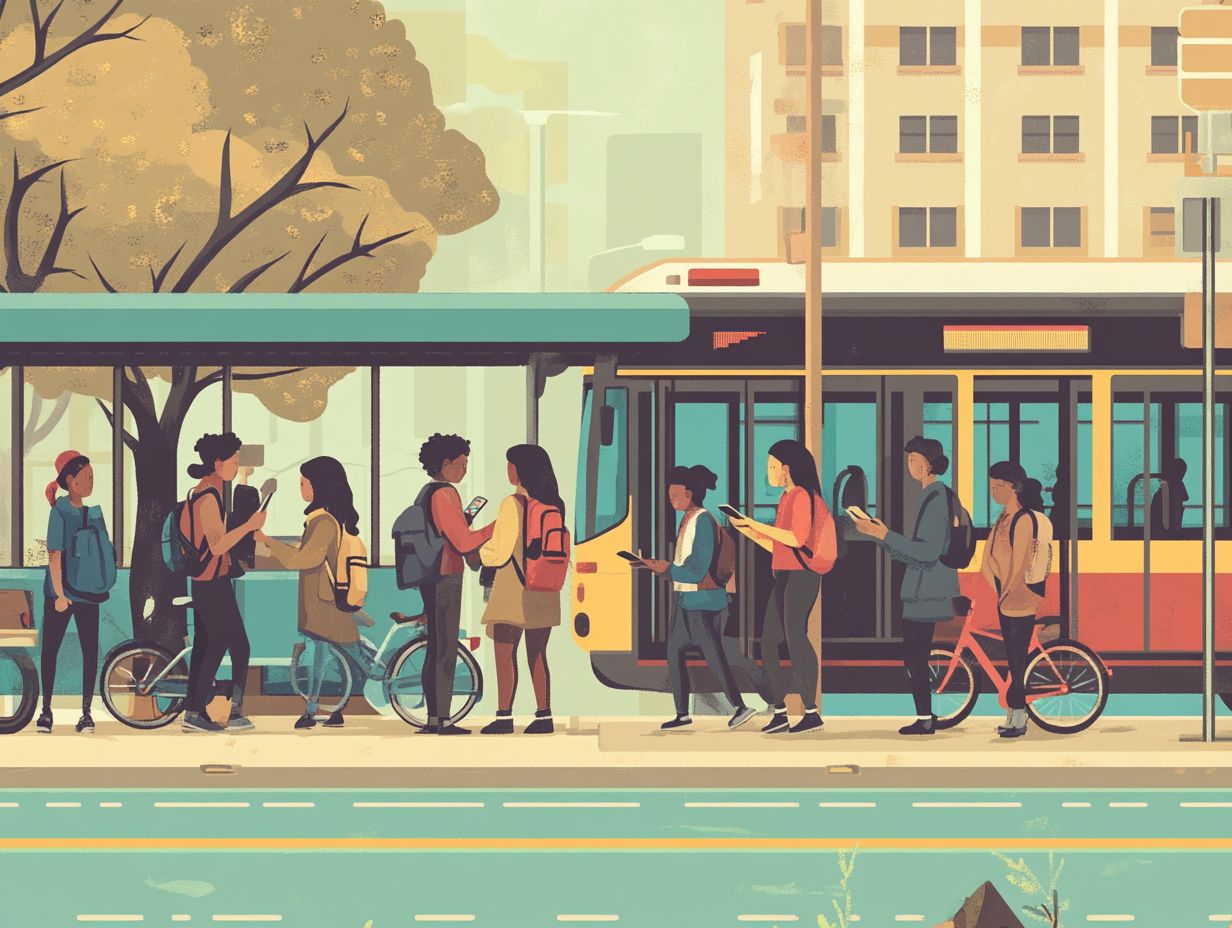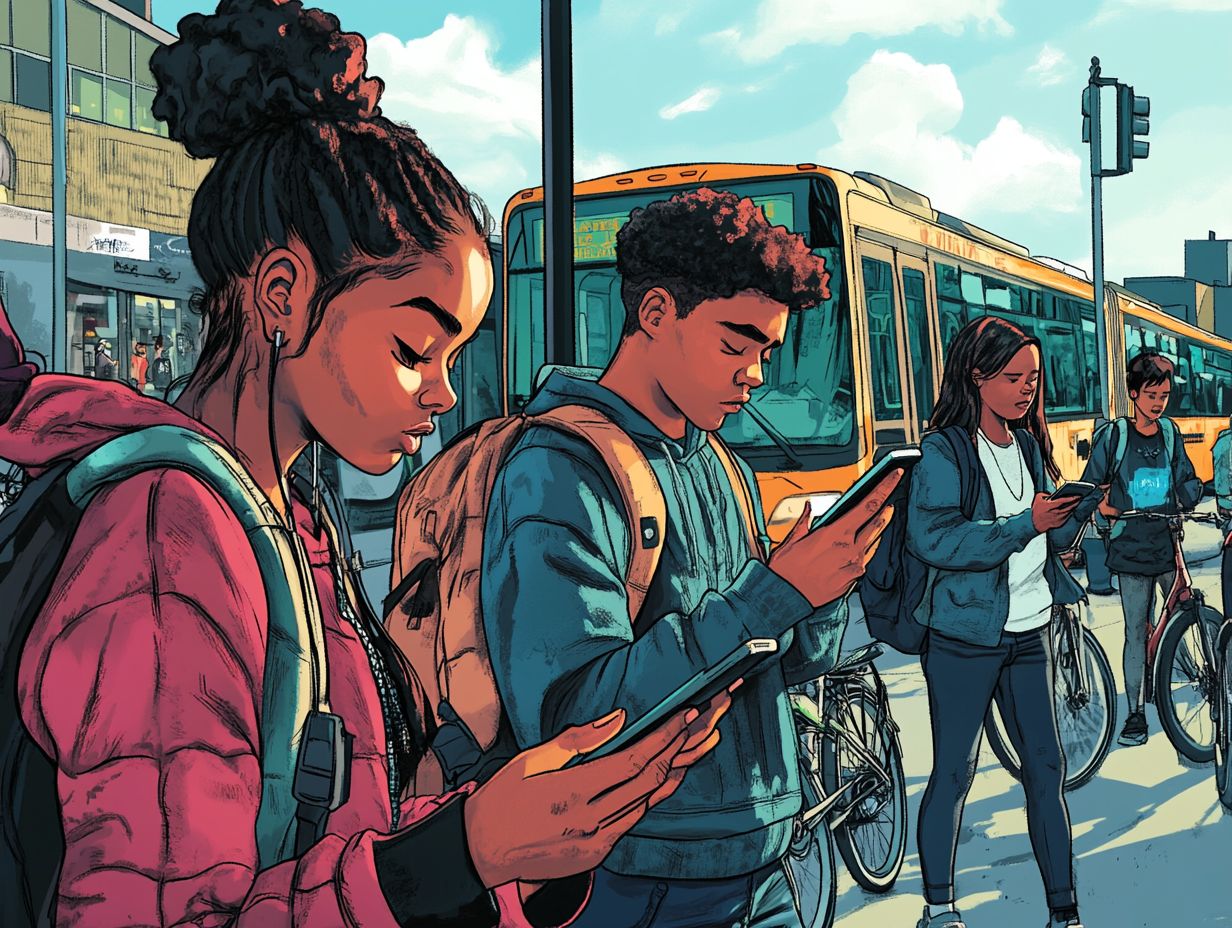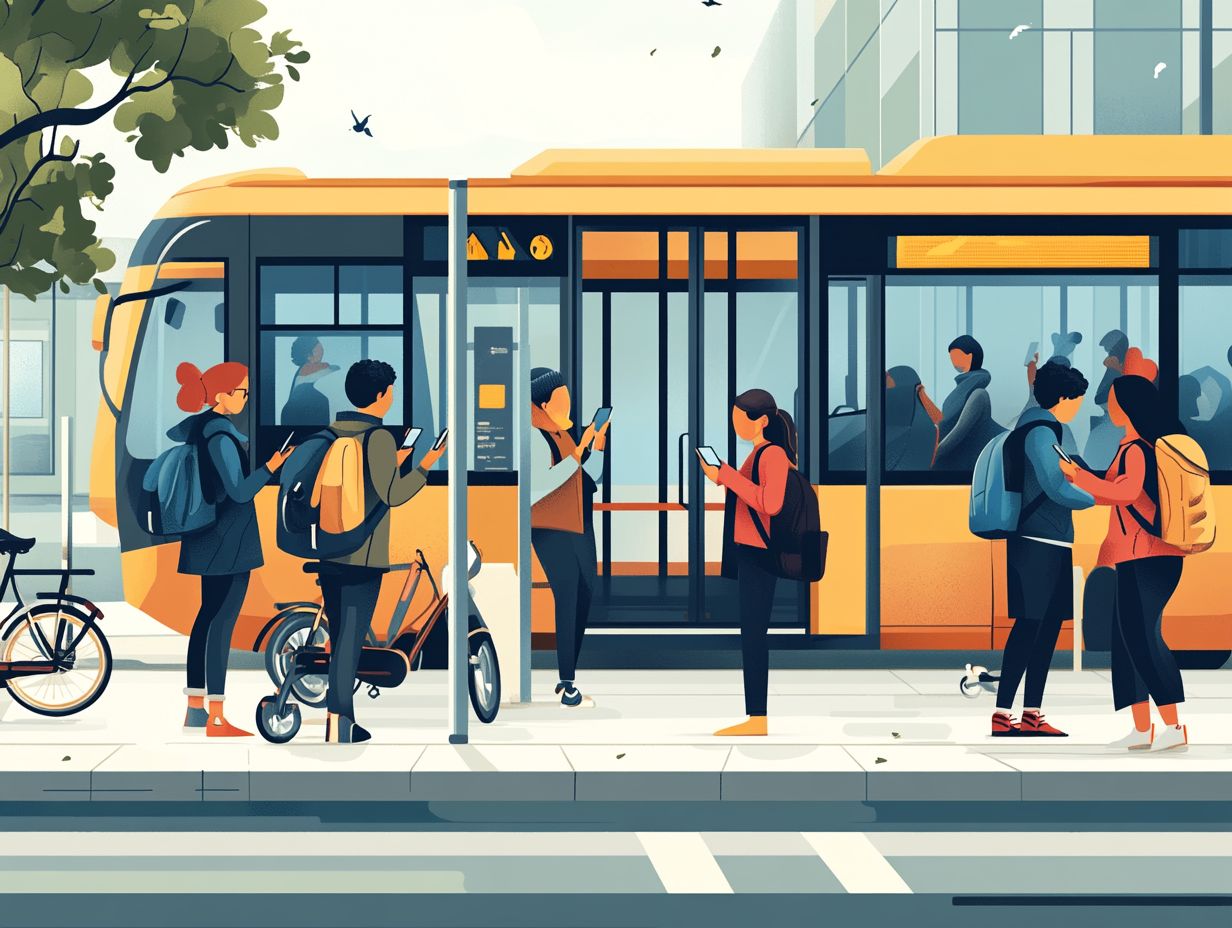Adapting to Local Transportation: A Student’s Guide
Navigating a new city can feel a bit daunting, particularly when you re trying to grasp the local transportation landscape. This guide is designed to help you decipher the array of options at your disposal, from public buses and trains to biking and walking.
You ll explore the advantages and disadvantages of each method, pick up tips on using maps and apps like a pro, and learn how to budget for your travel expenses. You ll also discover how to adapt to local customs and sidestep common pitfalls.
Get excited to explore your new environment with confidence!
Contents
- Key Takeaways:
- Understanding Local Transportation
- Navigating Public Transportation
- Considerations for Walking and Biking
- Budgeting for Transportation
- Adapting to Local Transportation Culture
- Frequently Asked Questions
- What modes of transportation are typically available in local areas for students?
- How much does it cost to use local transportation as a student?
- Do I need to have a specific form of payment to use local transportation?
- Is it safe to use local transportation as a student?
- How can I plan my route using local transportation?
- What should I do if I encounter any problems while using local transportation?
Key Takeaways:

Understanding Local Transportation
Knowing local transportation is key for students starting their journey in new cities, whether you’re wandering through the vibrant streets of Boston or discovering the eco-friendly pathways of UC Davis. Additionally, understanding local customs can greatly enhance your experience.
You have a multitude of options at your disposal. From public buses and trains like Unitrans to budget-friendly cycling routes and electric scooters, each choice not only prioritizes safety but also enriches your experience as an intrepid explorer.
These transport options offer chances for cultural immersion. They also help you manage your budget effectively. Familiarizing yourself with local norms and transportation services will prove invaluable as you navigate your new surroundings.
Types of Transportation Available
When you delve into the transportation options available to students, you’ll find that public transportation systems, cycling, and electric scooters become essential, especially in vibrant cities like Boston and UC Davis.
These modes of transport not only offer convenience but also address the varied demands of student life. In Boston, the Massachusetts Bay Transportation Authority (MBTA) provides a comprehensive network of subway and bus services, making urban commuting both budget-friendly and efficient.
Meanwhile, UC Davis champions cycling with extensive bike lanes and affordable rental options, ensuring safety for all riders. Electric scooters are also gaining popularity as a trendy choice for quick trips, enabling students to navigate their campuses and nearby areas with ease.
With these transportation alternatives at your fingertips, balancing academic obligations with social engagements becomes a seamless endeavor, all while keeping safety and budget in mind. Try out different options to find what works best for you!
Pros and Cons of Each Option
Exploring the pros and cons of each transportation option is essential for you to make informed decisions, whether you re navigating public transport in Boston or cycling around UC Davis.
With a variety of choices at your disposal, it s vital to weigh the financial implications alongside safety tips tailored to each mode. For instance, opting for buses or subways might present a cost-effective solution, especially with those unlimited monthly passes, but staying vigilant about your belongings is crucial.
On the flip side, biking offers an eco-friendly alternative that boosts your fitness, though it s imperative to don a helmet and adhere to traffic rules. Understanding these nuances enables you to select a transportation method that suits your lifestyle, ensuring both safety and effective budget management, while also recognizing that preferences can vary based on personal circumstances and commuting distances.
Navigating public transportation can feel overwhelming for students, particularly in vibrant cities like Boston or during a hectic day at UC Davis. However, by harnessing technology and using travel apps, you can transform this journey into a more manageable experience.
Familiarizing yourself with ticket purchasing systems, maps, and local protocols is crucial for a seamless ride. Plus, keeping safety tips in mind will bolster your confidence as you engage with these essential transit services.
Using Maps and Apps

Using maps and travel apps has become an essential skill for students like you navigating the public transportation maze in cities such as Boston and UC Davis. These tools provide real-time updates and navigation support that can make all the difference.
These digital companions also improve your commuting experience, offering features like step-by-step directions, estimated arrival times, and alerts for any pesky service disruptions. For example, apps like Google Maps and Citymapper not only guide you through complex transit routes but also suggest alternative paths when a bus is running late or a train is delayed.
By harnessing Global Positioning System (GPS) technology, these travel apps precisely pinpoint your location, ensuring you stay on the right track while providing useful insights like station amenities and user reviews. This level of connectivity transforms your commute from a chore into an efficient and even enjoyable journey.
Purchasing Tickets and Passes
Purchasing tickets and passes for public transportation becomes a breeze when you understand the systems in place, such as CharlieTickets in Boston and the Aggie Card at UC Davis. Knowing the system means you can travel with ease and confidence!
By familiarizing yourself with these options, you can navigate the transportation networks with confidence. In Boston, the CharlieTicket is not only convenient but also offers special deals when paired with your student ID, making public transit more budget-friendly.
Similarly, at UC Davis, your Aggie Card serves as a key to entry while granting access to exclusive discounts on transportation services. By exploring these partnerships and potential deals, you can significantly reduce your expenses while enjoying the benefits of seamless travel across your campus and beyond.
Considerations for Walking and Biking
Thinking about walking or biking? Keep these important factors in mind. Safety tips, bike safety regulations, and the likelihood of encountering campus wildlife especially in eco-conscious settings like UC Davis should all be on your radar.
Embracing these modes of transport doesn’t just cultivate a sustainable transit culture; it also enhances your journey, allowing you to engage with your surroundings in a meaningful and mindful way, as a young explorer eager to make the most of each experience.
Safety Tips
Safety tips are essential for you as a student, especially if you choose to walk or bike in urban environments where campus wildlife and varying road conditions can present unique challenges.
Navigating through bustling streets filled with vehicles and unexpected obstacles requires your vigilance and preparation. When you re biking, it s crucial to wear a properly fitted helmet and ensure your bicycle is equipped with functioning lights and reflectors to boost your visibility during low-light conditions.
When you walk, stay alert and stick to designated paths to reduce accident risks. Traveling in groups not only enhances your personal safety by deterring potential threats but also fosters a supportive community atmosphere.
Encouraging your peers to adopt these practices will help make safety a collective priority during your daily commutes.
Benefits and Challenges
Walking and biking offer students great benefits, but they also come with challenges. These include factors like fitness, environmental impact, and the hurdles presented by traffic and weather conditions.
Engaging in these modes of active transportation significantly enhances physical health by promoting cardiovascular fitness and reducing the risk of illness. They provide an eco-friendly alternative to motorized vehicles, helping to lower carbon footprints and minimize air pollution.
However, students often encounter obstacles such as unpredictable weather, which can dampen the spirits of even the most committed cyclists or walkers. Safety concerns arising from busy streets and the absence of proper bike lanes present real risks, prompting students to weigh their enthusiasm for these healthier choices against the practical challenges they may face each day.
Get out there and enjoy the fresh air while biking to class!
Budgeting for Transportation

Budgeting for transportation is an essential aspect for you as a student. It is crucial when seeking to optimize your travel expenses. Whether you re relying on public transportation in Boston or cycling around UC Davis, understanding the costs involved can make a significant difference.
By exploring money-saving tips, you can manage your financial commitments while savoring new experiences and embracing diverse cultural perspectives during your travels.
Costs to Consider
When budgeting for transportation, account for various costs associated with public transport in cities like Boston and UC Davis. This includes ticket prices, passes, and any potential discounts available through your school.
Navigating these expenses may seem overwhelming, especially when considering options like rideshares, biking, or car rentals. Public transit systems often offer student passes that can significantly reduce your commuting costs.
Rideshare companies frequently provide discounts or special rates for students, making it easy to share a ride without stretching your budget. By exploring these resources, you can manage transportation costs effectively while cultivating financial savvy and promoting a more budget-conscious lifestyle.
Money-Saving Tips
Implementing money-saving tips is crucial for you as a student aiming to enhance your transportation budgeting while immersing yourself in your community.
Take advantage of available student discounts to significantly cut down on commuting costs, whether you’re using public transit or rideshare services. Many cities collaborate with local institutions to offer fare reductions or special programs designed to make travel more affordable.
Consider alternatives like biking or carpooling, which can lead to considerable savings. Effectively managing your travel budget fosters financial responsibility and promotes a more sustainable lifestyle.
Adapting to Local Transportation Culture
Adapting to the local transportation culture is essential for you as a student. Understanding local transportation as a student in cities like Boston and UC Davis can enrich your overall experience and help you connect with your environment.
This awareness helps you navigate public transportation with ease and ensures a respectful engagement with the local communities you encounter.
Etiquette and Customs
Understanding the etiquette and customs of public transportation can enhance your experience as a student in cities like Boston and UC Davis.
Being mindful of your surroundings creates a better environment for everyone on board. Simple practices, such as offering your seat to those who may need it more, like the elderly or disabled, and keeping your noise levels in check, are impactful.
Be aware of designated standing areas and keep the aisles clear of backpacks and personal belongings. Actions like respecting personal space and disposing of trash properly reflect positively on the student community and contribute to a more enjoyable commuting experience for everyone.
In conclusion, budgeting for transportation is vital. By following these tips, you can enhance your travel experience while maintaining financial health. Don t miss out on student discounts check them out today!
Common Mistakes to Avoid

Being aware of common mistakes to avoid can enable you to get around public transportation easily, allowing you to fully enjoy your travel experiences.
You might neglect planning your routes or underestimate travel durations. Recognizing these missteps can reduce stress and improve your daily commute. Don t forget to compare prices. Look for budget-friendly travel passes that can save you money over time. Ignoring the value of real-time navigation apps can lead to missed connections and unnecessary delays.
Tackle your routes strategically and make the most of available resources to elevate your money-saving skills and move through public transport with confidence and grace.
Frequently Asked Questions
What modes of transportation are typically available in local areas for students?
Students have plenty of great choices for local transportation, including buses, trains, subways, taxis, and ride-sharing services like Uber or Lyft.
How much does it cost to use local transportation as a student?
The cost of local transportation for students can vary, but many cities offer discounted fares or student passes. It’s important to research and compare prices to find the most affordable option.
Do I need to have a specific form of payment to use local transportation?
In most cases, cash or a debit/credit card are accepted forms of payment for local transportation. Some cities also offer the option to purchase a reloadable transit card for convenience.
Is it safe to use local transportation as a student?
Local transportation is generally safe for students, but it’s important to take precautions such as staying aware of your surroundings, avoiding late-night travel alone, and always following safety guidelines provided by the transportation system.
How can I plan my route using local transportation?
There are several resources available for students to plan their routes using local transportation, such as transit apps, online trip planners, and schedules posted at transportation stops. It’s also helpful to familiarize yourself with the main transportation hubs in your area.
What should I do if I encounter any problems while using local transportation?
If you encounter any issues while using local transportation, such as delays or safety concerns, it’s important to report them to the transportation authority or seek assistance from transportation staff. You can also reach out to fellow students or local resources for guidance and support.






